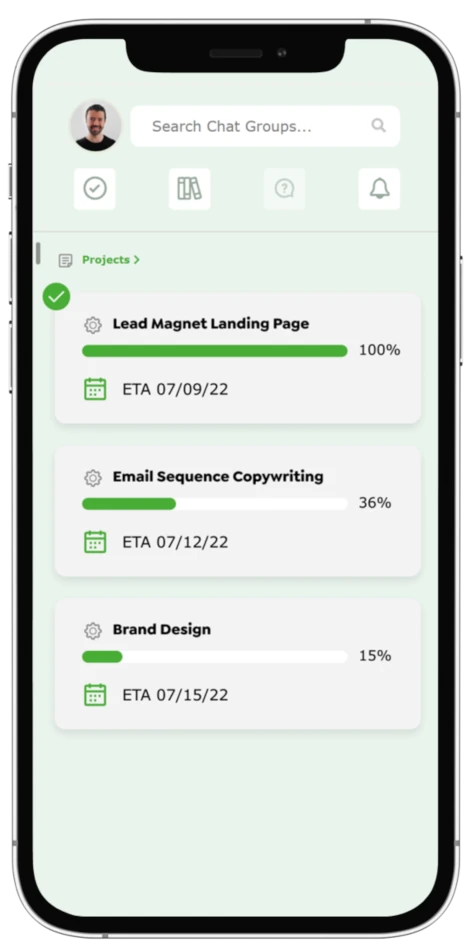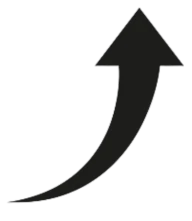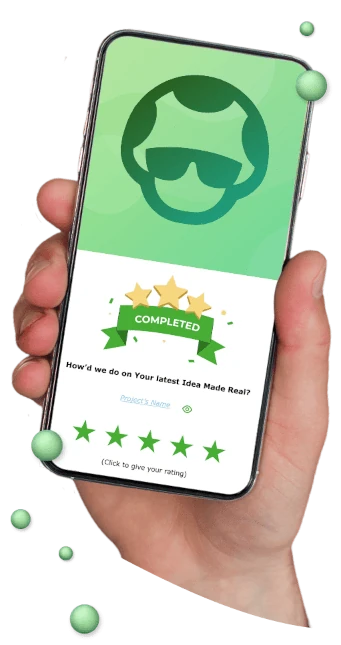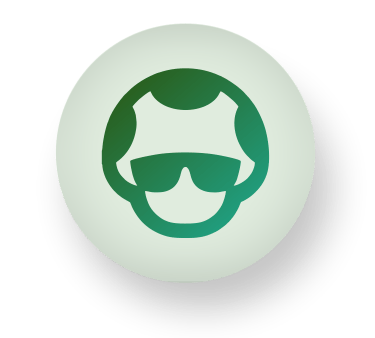Ultimate Sales Funnel Template: No More Guessing. Get It Free

Suit up, and sit down.
It’s funnel time baby!
:: queue 80’s MC Hammer beat ::
If you’re reading this, it’s because you want to know how to create a sales funnel that’s easy to copy, that isn’t way too complex, and that—of course—gets results.
(If you’re new here btw, you should know that I’ve got a bit of experience on sales funnels. We’ve generated over $25MM+ in revenue for our clients. And the most common task our clients delegate to AutoGrow is their sales funnel strategy and implementation.)
That’s why in this article:
- I’ll share 10 proven sales funnel templates for SaaS, eCommerce, coaches, local events, online courses, and info products.
- You’ll get to download our simple and advanced sales funnels for free.
- Plus I’ll share a walkthrough and my thoughts on why some of those sales funnels work and why they’ll work for your business too.
Let’s break it down, here we go…
What Is a Sales Funnel & Why Does It Matter?
Sales funnels have attained almost buzzword-like popularity in marketing circles these days.
And like most buzzwords, “sales funnels” is a phrase that’s often misused and misunderstood.
So let’s cut through the fog of confusion and lay it all out on the table: what’s a sales funnel? And most importantly, why does having a sales funnel for your business even matter?
A sales funnel is a series of marketing assets set up in a sequential order designed to turn prospects into paying customers.
Or as I defined it in an earlier post…
A sales funnel is a series of steps designed to guide visitors towards a buying decision. The steps are composed of marketing assets that do the work of selling, like landing pages and emails.
A significant number of businesses (over 570,000 to be exact), are turning to sales funnel technologies (SaaS tools, apps, etc.) to improve their performance, according to data originally from BuiltWith.
And from those 570,000 businesses using at least one sales funnel technology, about 319,900 websites are using ClickFunnels.
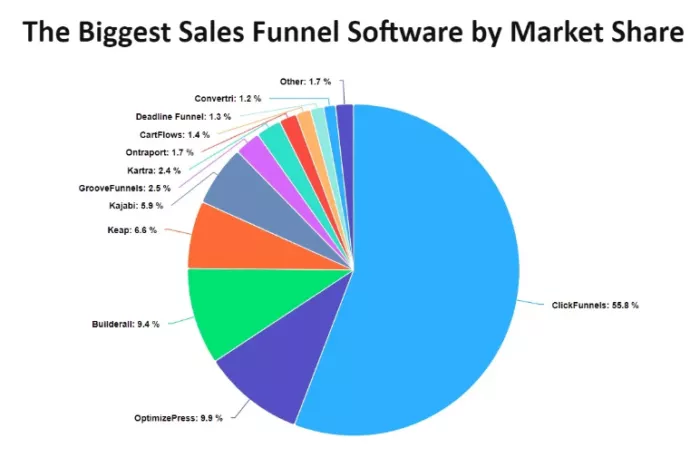
For instance, a super duper simplified sales funnel could go something like this…
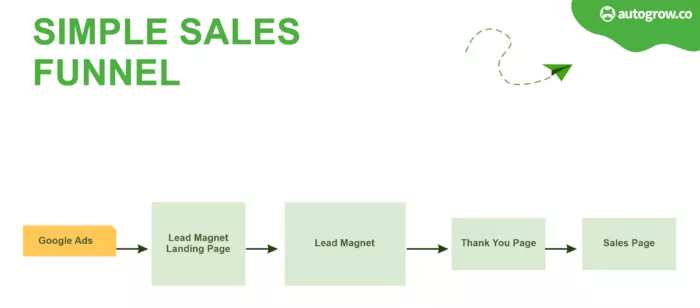
In this example, you attract customers with a paid ad, win their trust with a free lead magnet, and you convert them to a loyal and loving customer through your sales page.
Simple, right?
Well, for some people, creating their funnel strategy isn’t that simple. That’s why most of our clients delegate to us their sales funnel strategy and implementation.
But now, if you go out and Google “sales funnel,” you’re likely to get back a bunch of images like this…
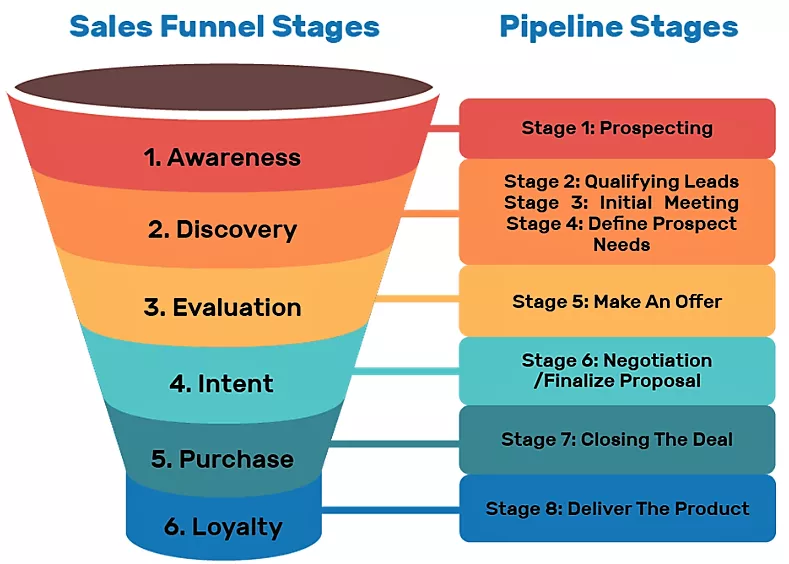
See how the funnel’s all broken down into different stages? Awareness, Discovery, Evaluation…
There are tons of sites that have pretty much taken this example and reiterated it on their own pages.
And in a sense, they’re right! This is a sales funnel (technically).
And more to the point, it illustrates how a sales funnel works: it shuffles your prospects along through each stage until they are nurtured enough and ready to buy.
See, when a prospect enters the first stage of your funnel, they’re not ready to buy what you’re selling yet.
But as they move through your funnel, they’re learning more about how your product or service solves a problem for them. They’re discovering all the different kinds of solutions to that problem. And ultimately, they’re being convinced why what it is you’re selling is the solution to that problem.
And THAT is when they’re ready to buy.
Here’s an example of an agency sales funnel.
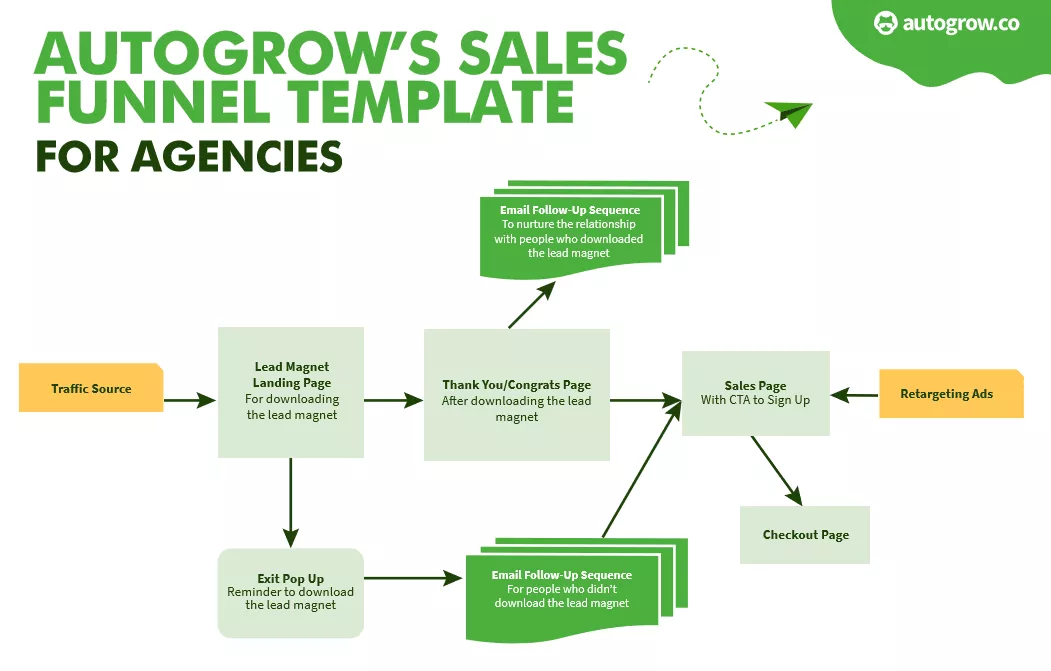
But the way that our sales funnel discussion differs from images like those above is that we’re going to look at the exact types of assets to be used in each stage of a buyer’s journey.
We’re going to point out where your ads need to go. Which paths prospects should be sent down after not engaging with your content. What sequence of content types should be used to close the deal.
We’re going to look at the concrete (landing pages, upsell emails, blog pages, etc.) rather than the abstract (awareness, discovery, evaluation, etc.).
But more on that in a sec. First let’s answer the biggest question you likely have about sales funnels…
Why Should I Care About Sales Funnels?
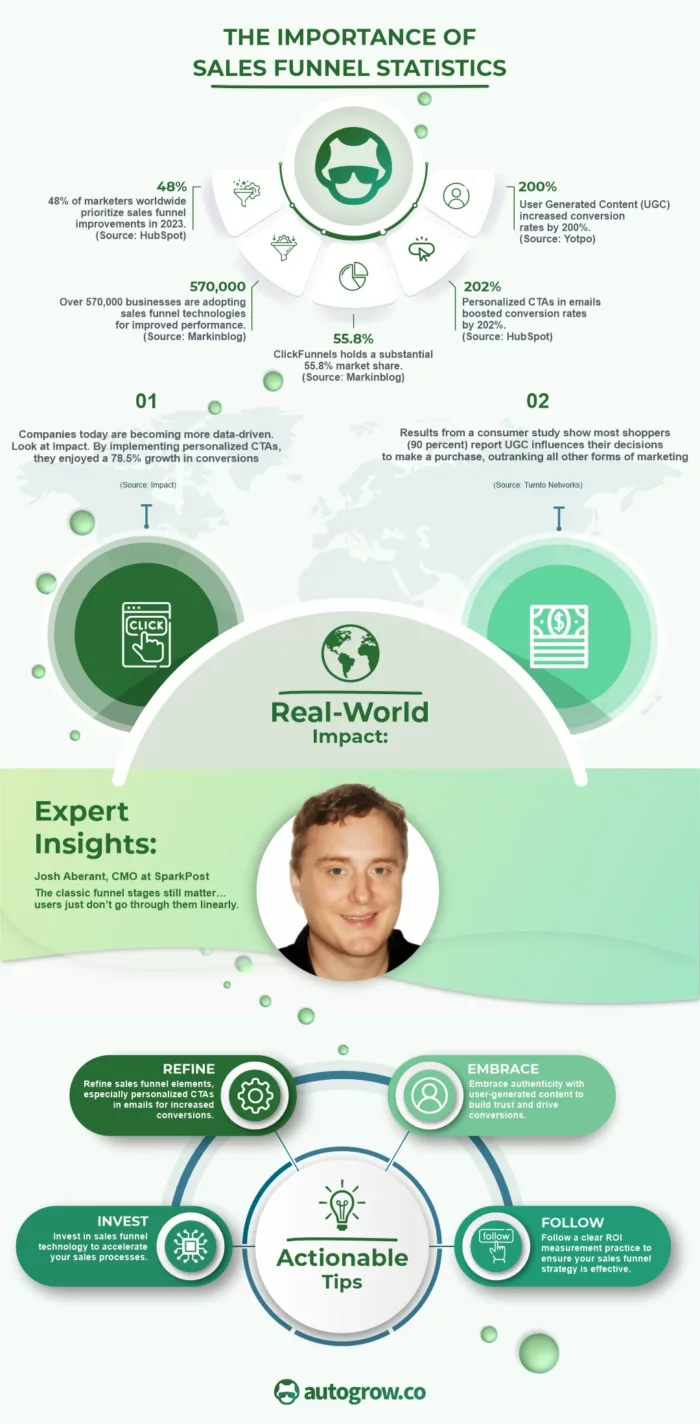
This one’s easy.
You should care about sales funnels because a sales funnel can save you massive time and massive dough.
And once your sales funnel is set up properly, it practically automates your lead generation.
Here’s how…
Do you know what 65% of sales teams say is their biggest challenge according to Hubspot?
Prospecting and qualifying leads.
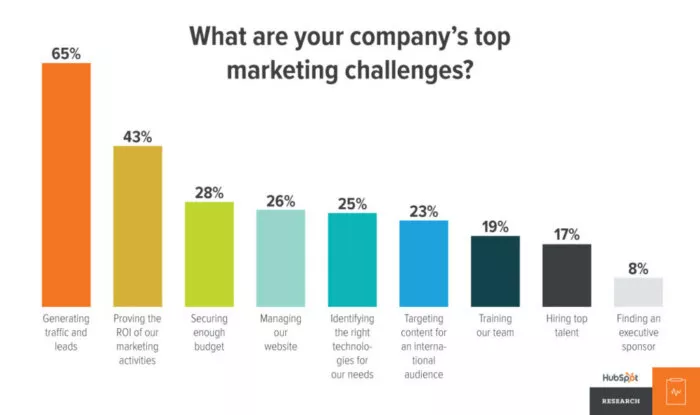
That’s 2 out of every 3 marketers saying that finding new leads and qualifying them is waaaaaaaay harder than closing the sale.
When your leads are qualified and are a fit for your product or service, your sales team doesn’t have to do a whole lot to get those leads onboard.
Why? Because all their objections are already addressed.
They’ve already had all their questions about their problems answered. And they’ve already been shown the light—your product is the obvious solution they’ve been looking for.
In fact, according to VSA, “selling” only takes up about 34% of most sales teams’ time.
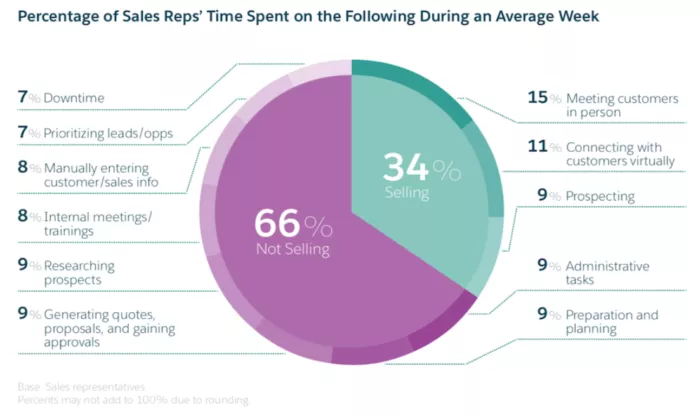
So imagine this: what if lead generation and qualification all become automatic?
What if you could free up a huge portion of your sales staff’s time?
Or if you’re the one fielding all the calls and closing the deals, what if you didn’t have to spend 10, 20, 30 hours a week hunting for new clients and qualifying leads?
That is the power of a sales funnel.
It does all the hard work of selling for you. And that means you can spend more time on where it counts most—growing your business.
And if you want to get the absolute most out of your sales funnel be sure to take a page from the 19 best sales funnel examples we’ve put together.
Now, I’ll walk you through each of our sales funnel templates so that you can model them...
#1 Ultimate Sales Funnel Template — Super Simple Funnel
Like many problems in life, the solution to bringing in more and higher-quality leads to your funnel lies in simplicity.
No need to overcomplicate. No need to put in more work than is necessary. And no need to go rogue building out untested strategies.
Because honestly, most businesses will only need a “simple” sales funnel in order to start getting results.
That’s where this ultimate super simple sales funnel template comes in.
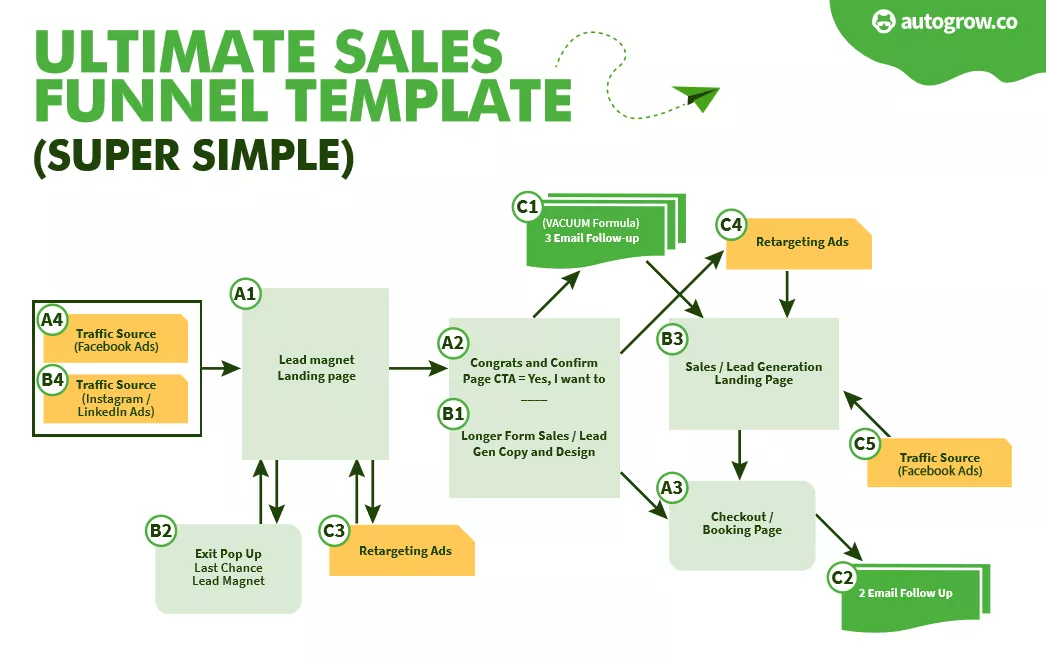
This sales funnel template has all the basic necessities of a minimum viable sales funnel plus a variety of added strategic techniques for hooking in prospects, propelling them to your checkout page, and nurturing and qualifying them along the way.
Super Simple Sales Funnel Template Walkthrough
I’ll walk you through how this ultimate super simple sales funnel template works.
- Ads – First, leads are brought in by paid ads, either through social media (we tend to primarily use Facebook and LinkedIn) or through Google (don’t forget to nail your Google ads headlines btw). This is the fuel for your sales funnel. And although it’s only step #1, nailing this part of the funnel is absolutely key to the rest of it working as it should.
- Lead Magnet Landing Page – Your ads should bring in prospects by referencing your lead magnet. The point of a lead magnet is to offer a free item of value (ebook, coupon, webinar, etc.) in exchange for your prospect’s email address. That way, you have the contact info needed to keep nurturing them through your funnel.
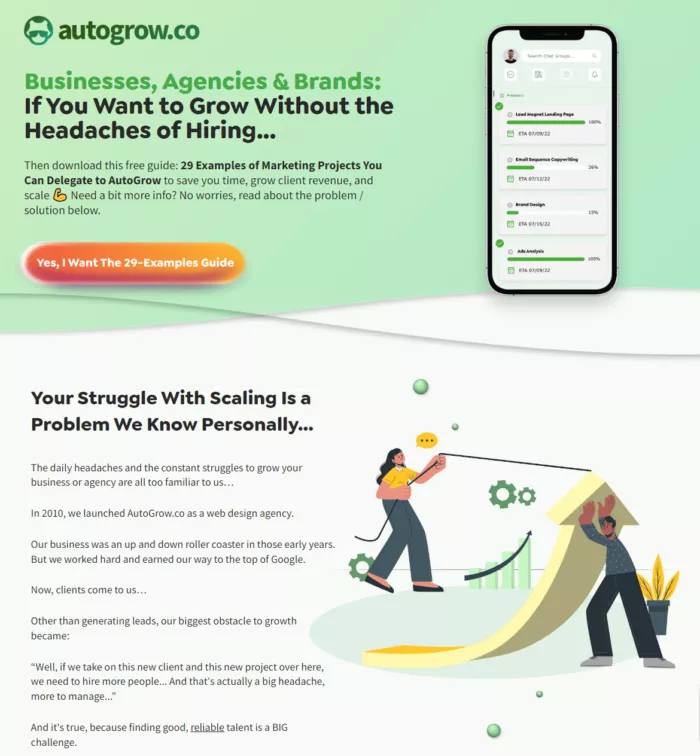
- Lead Magnet Landing Page Retargeting – Your lead magnet landing page should have 2 types of retargeting strategies: an exit pop-up and retargeting ads.
- Thank You / Congratulations Page – Once your prospect downloads your lead magnet, they’ll be redirected to a “Thank You” page. We’ve found that positioning this page as a “Congratulations” page instead is a great way to build enthusiasm and to keep leads moving forward.
- Long-Form Sales Page – Your ”Congratulations page” should also be directly connected to a long-form sales/lead gen page. This page should follow all the best practices of a high-converting sales page. The only difference is that it’s actually attached to your Congratulations page. That way, you don’t have to worry about prospects dropping out of your funnel between pages.
- Email Follow-Up or Checkout Page – After your sales page, prospects who are interested in your offer will be redirected to a booking or checkout page where they’ll buy your product or service. If they instead drop off your sales page without buying, they’ll be retargeted to your sales page again using a 3-email follow-up.
- Sales Page Traffic / Retargeting – This sales funnel template also includes a separate sales page (same as the original, just without the Congratulations portion at the top). Retargeting ads and Google search ads will direct prospects to this page.
- Email Follow-Up After Checkout – Finally, after a prospect buys your product or books a call with you, they’ll receive a 2-email follow-up sequence. This sequence is designed to keep nurturing your prospects even after the sale so that they can get even more value out of what it is you’re offering. And as a result, they’re bound to turn from simple customers into brand loyalists and returning clients.
Why Does This Super Simple Sales Funnel Template Work?
Simply put, this super simple sales funnel template works because it’s got everything a successful sales funnel needs...
- A diverse source of funnel traffic
- The core funnel pages (Lead Magnet Landing Page, Congrats / Thank You Page, Sales Page, Checkout Page)
- Retargeting and nurturing elements (email follow-ups and retargeting ads)
On top of that, we’ve used this same funnel to achieve the following fantastic results for our clients…
- Led to a 7:1 return on investment for one info product client
- Created a massive 86% conversion rate for one entrepreneur’s lead magnet
- Brought in 200+ new leads for an interior designer we worked with
Now let’s take a look at the second sales funnel template…
#2 Ultimate Sales Funnel Template — Advanced Funnel
In most cases, simplicity is the best solution.
If you can bring in an adequate number of leads that are high-quality with a simpler funnel, then that should be the #1 choice.
However, some businesses may be better served by more complex funnels.
And that’s where our ultimate advanced sales funnel template comes in.
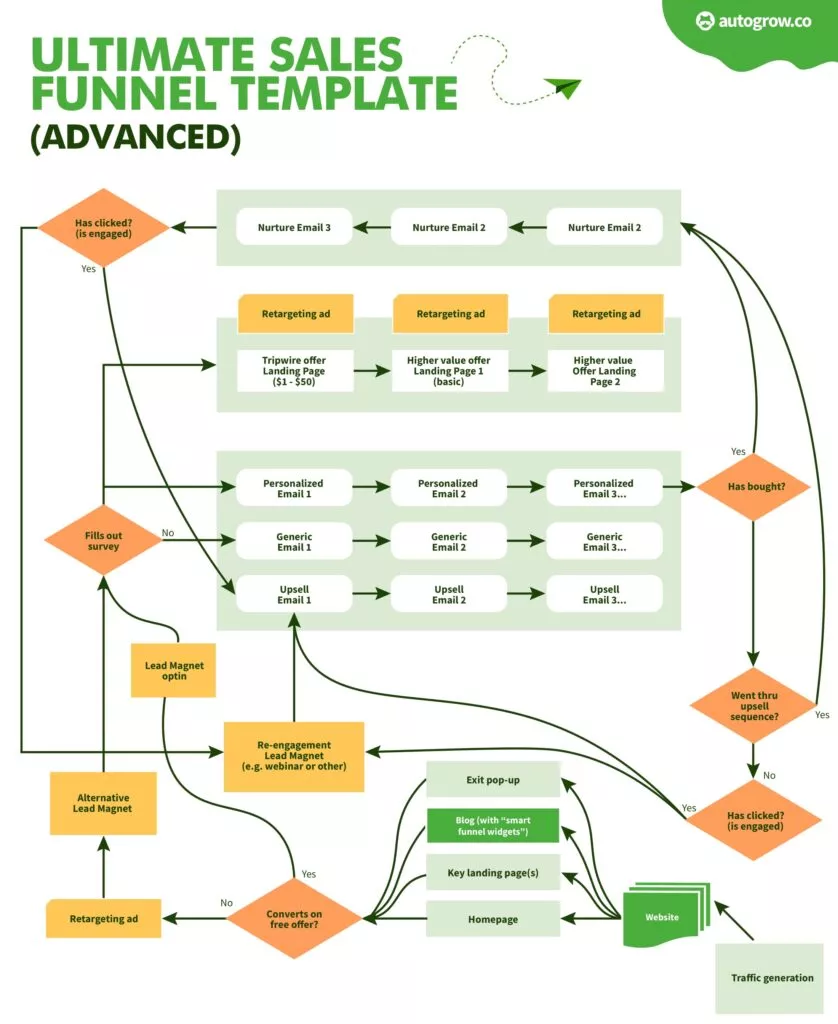
Quite a bit more going on here, huh?
This type of funnel can be thought of as more of a “second step.”
Once you’ve built out your simple funnel and have seen consistent and high-quality leads coming in, it’s time to tweak it to produce even more impressive results.
And this is what we’ve found works when businesses are trying to achieve those more impressive results.
Advanced Sales Funnel Template Walkthrough
Let’s take a closer look at the flow of this advanced sales funnel template.
Now, this funnel takes what works from the simpler sales funnel template above and improves on it even further. So right now, I’ll just take you through the differences between the 2 templates.
For example, you’ll notice that there are actually 3 lead magnet offers in this template. That way, there are twice as many chances to capture leads with valuable info and bring them into your funnel.
After that, a survey separates them from receiving personalized emails and a tripwire offer or generic emails meant to warm up the prospect even further.
If after these email sequences the prospect has not yet bought, they are directed to an upsell sequence or another lead magnet if they haven’t shown engagement along the way.
Why Does This Advanced Sales Funnel Work?
This funnel is particularly great for high-ticket products or services.
Why?
Because high-ticket products or services require significantly more nurturing in order to turn leads into customers. And by the way, there are sales strategies to close 481%+ more high-ticket sales.
On top of that, though, this funnel is also especially great at taking prospective customers through every single stage of your customer journey.
For example, low-engaging prospects are guided through generic email sequences before receiving personalized emails. And if they still stay at a low-engagement, then they’re led to a specialized lead magnet meant to reignite their interest in your product or service.
For high-engaging prospects, there are upsells, which can be an enormous source of additional revenue.
For example, have a look at this graph that outlines the financial impacts of improving customer acquisition, monetization, or retention by just 1%.
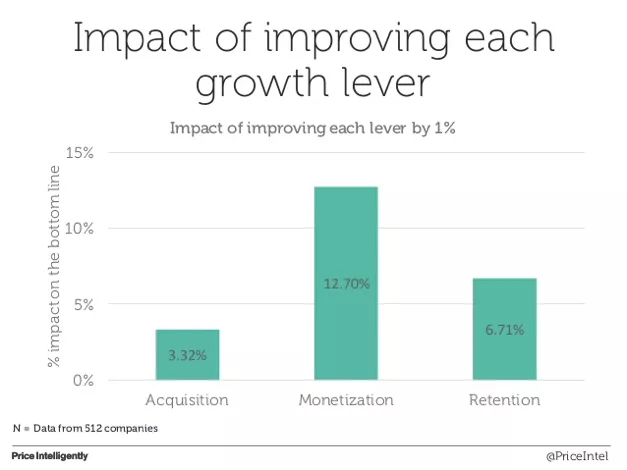
As you can see, a simple 1% increase in monetization of a single customer can improve your bottom line by 12.70%—9.38% higher than acquisition and 5.99% higher than retention.
And upselling is without a doubt one of the best ways of increasing the monetization of a single customer.
When you know how to upsell the right way, this sales funnel template gives you the perfect opportunities to capitalize on high-engaging prospects and increase your value per customer.
Here’s a video that goes into the basics of a sales funnel and how both—simple and advanced sales funnel templates work.
These two core sales funnel templates (simple and advanced) work great for nearly any business in any industry.
And in all likelihood, they’re probably going to work great for your business too.
That being said, businesses in some industries can stand to benefit from using more specialized funnels.
And luckily, we’ve already built out templates for these industries in particular.
So have a look below and if you see one that matches the industry you’re in, give it a look and download yours now.
#3 Ultimate Sales Funnel Template — Local Events Sales Funnel
If your business is looking to host a workshop, meet and greet, seminar, or any other type of local event, you need to have the best marketing tools at your disposal to make it a success.
That’s where our local events sales funnel comes in.
At AutoGrow, we’ve found that there are 2 types of sales funnels in particular that work well for this business model.
First, there’s “Old Reliable.”
Local Events Sales Funnel Template “Old Reliable”
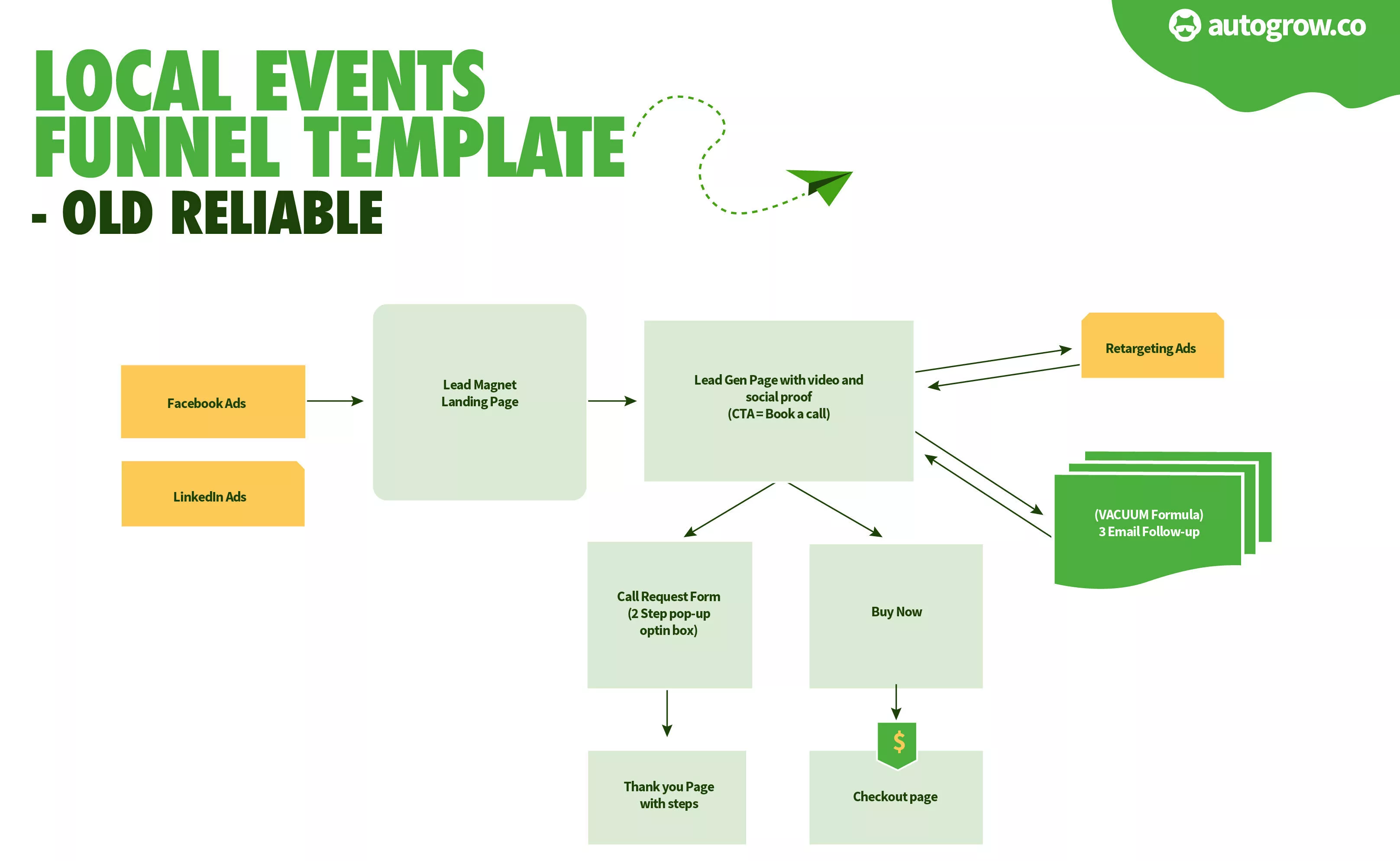
This template gives your visitors everything they need to 1) get the information they need to make an informed decision and 2) register for your event.
It also includes light retargeting tactics to bring prospects back into your funnel.
Then there’s what we call “The Retargeter.”
Local Events Sales Funnel Template — “The Retargeter”
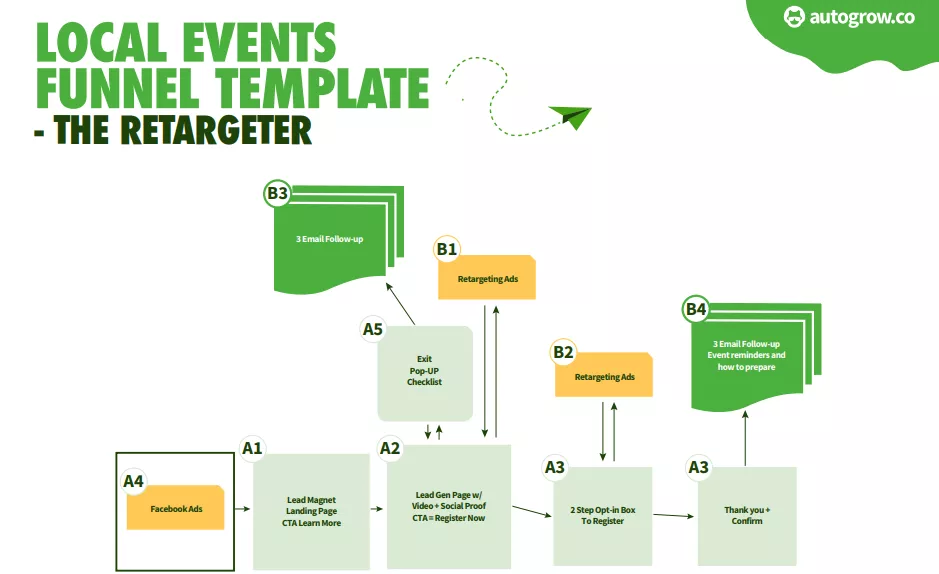
This sales funnel is heavy on retargeting tactics.
Two sets of retargeting ads, two different email sequences, and an exit pop-up ensure that anyone who drops out of your funnel is going to have the highest chances possible of getting sucked back in.
#4 Ultimate Sales Funnel Template — SaaS Sales Funnel
The SaaS business is rapidly growing in popularity these days.
In fact, according to Statista, revenue in the SaaS market is projected to reach $258.60bn in 2023. And revenue is expected to show an annual growth rate of 7.69%—resulting in $374.50bn by 2028.
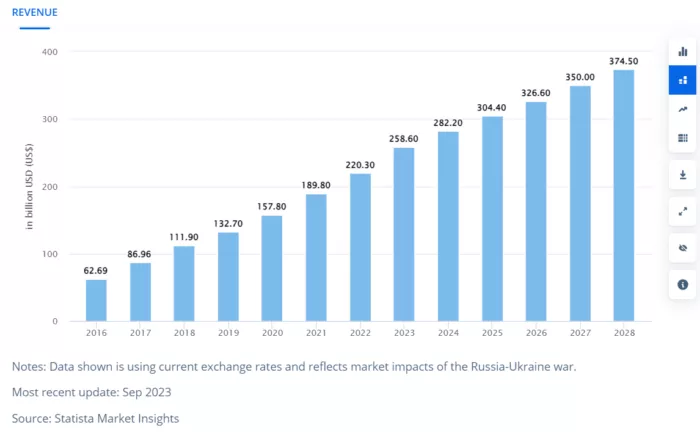
Now, the trick to capitalizing on this growth is knowing how to market your SaaS business well with the perfect SaaS sales funnel.
And I’ve got today 2 SaaS sales funnel templates designed to do just that.
First, we’ll go over our “basic” SaaS funnel.
SaaS Sales Funnel Template — Basic
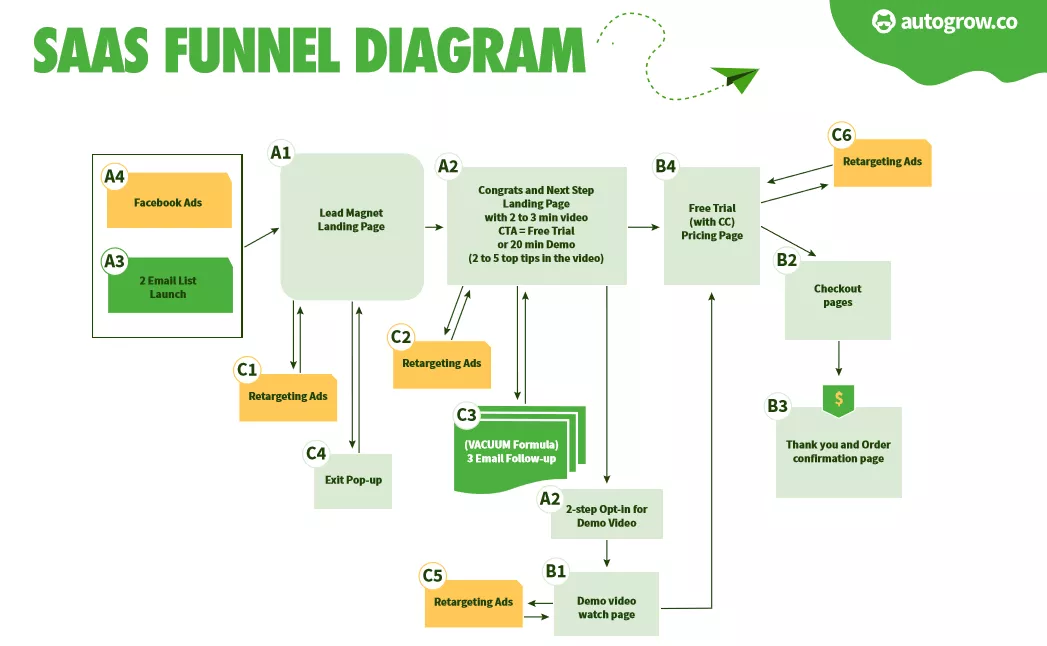
This basic SaaS sales funnel template comes with loads of assets that are perfect for the SaaS model—namely the free trial (with a credit card) and the demo video page.
There are also plenty of opportunities for retargeting ads.
SaaS Sales Funnel Template — “60-Day ‘Long’ Trial Downsell/Upsell”
I also templated out what I call the SaaS “60-Day ‘Long’ Trial Downsell/Upsell” funnel.
This type of SaaS sales funnel template actually comes from my personal experience using SamCart.
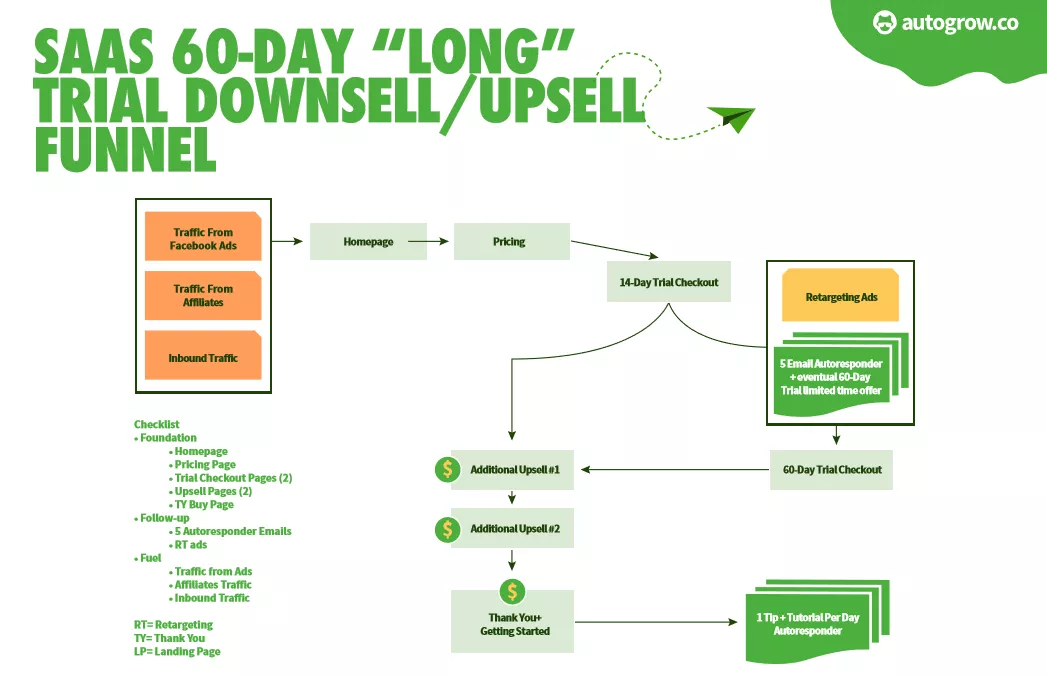
It features a practically unheard of 60-day trial.
Now, you may be thinking, “Why in God’s name would I want to give free access to my product for 2 frikkin months??”
And the short answer is, because it works.
You see, at the beginning of my trial with SamCart, I wasn’t ready to invest $99.
But after a 14-day trial and then a 60-day trial, SamCart had become so deeply embedded in our processes that I gladly paid that and more to keep its functionality.
Lesson here: if you’re selling a great product, you can benefit from this SaaS sales funnel template.
#5 Ultimate Sales Funnel Template — eCommerce Sales Funnel
The eCommerce business model is, of course, incredibly popular. And right now, when home delivery of products is practically essential, it’s seeing more action than ever.
The U.S. Census Bureau estimated that U.S. retail eCommerce sales for the second quarter of 2023 was $277.6b. .
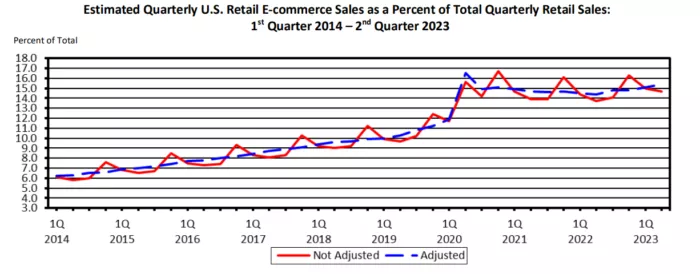
This was an increase of 2.1% from the first quarter of 2023
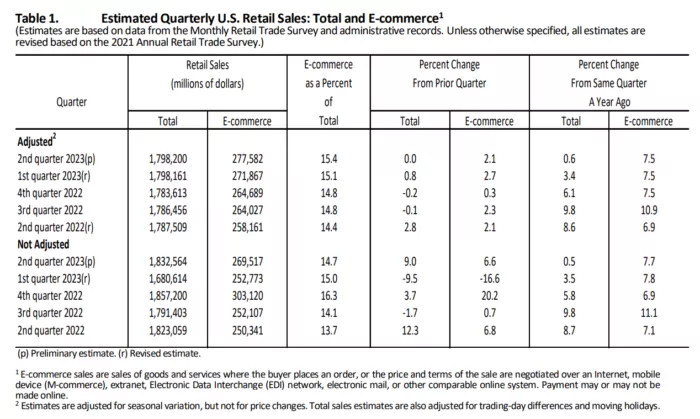
And with each passing year, online sales are making up a larger percentage of total retail sales in the United States.
U.S. eCommerce sales reached for the first time $1.03 trillion in 2022 according to the U.S. Census Bureau.
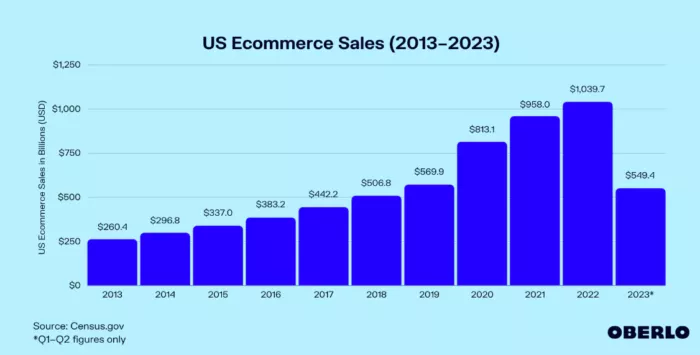
But capturing that value takes having the right sales funnel on your side.
That’s where our eCommerce sales funnel comes in.
First up is our “Knowledge-Based” eCommerce sales funnel.
eCommerce Sales Funnel Template — “Knowledge-Based”
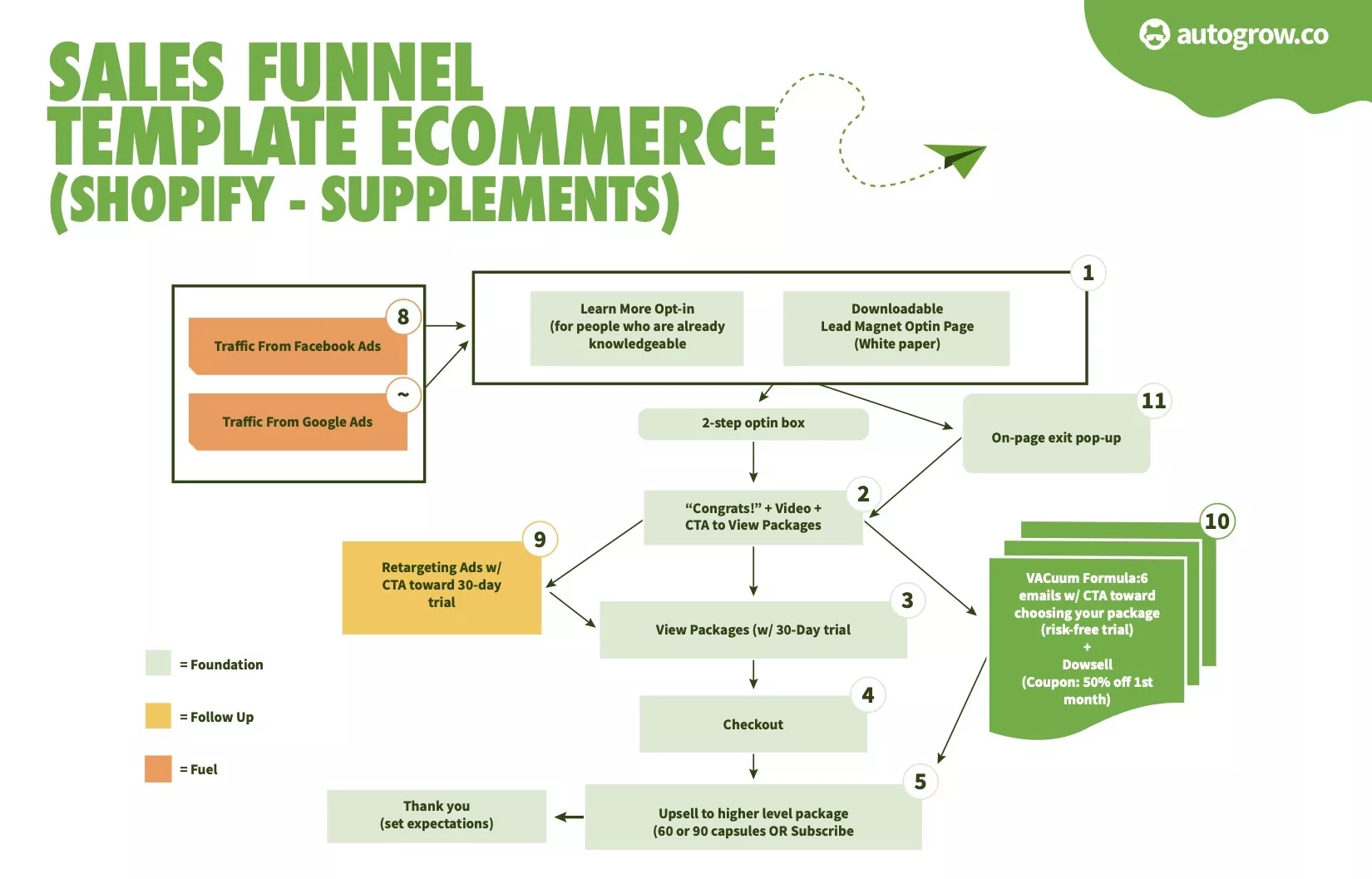
One unique feature about this eCommerce sales funnel is that there are 2 places where prospects can opt in.
One is a “learn more” page designed specifically to target prospects already knowledgeable about the product. And a lead magnet for prospects who need a bit more education on the industry or product.
Now let’s move to the “Pre-Sale Page” eCommerce funnel.
eCommerce Sales Funnel Template — “Pre-Sale Page”
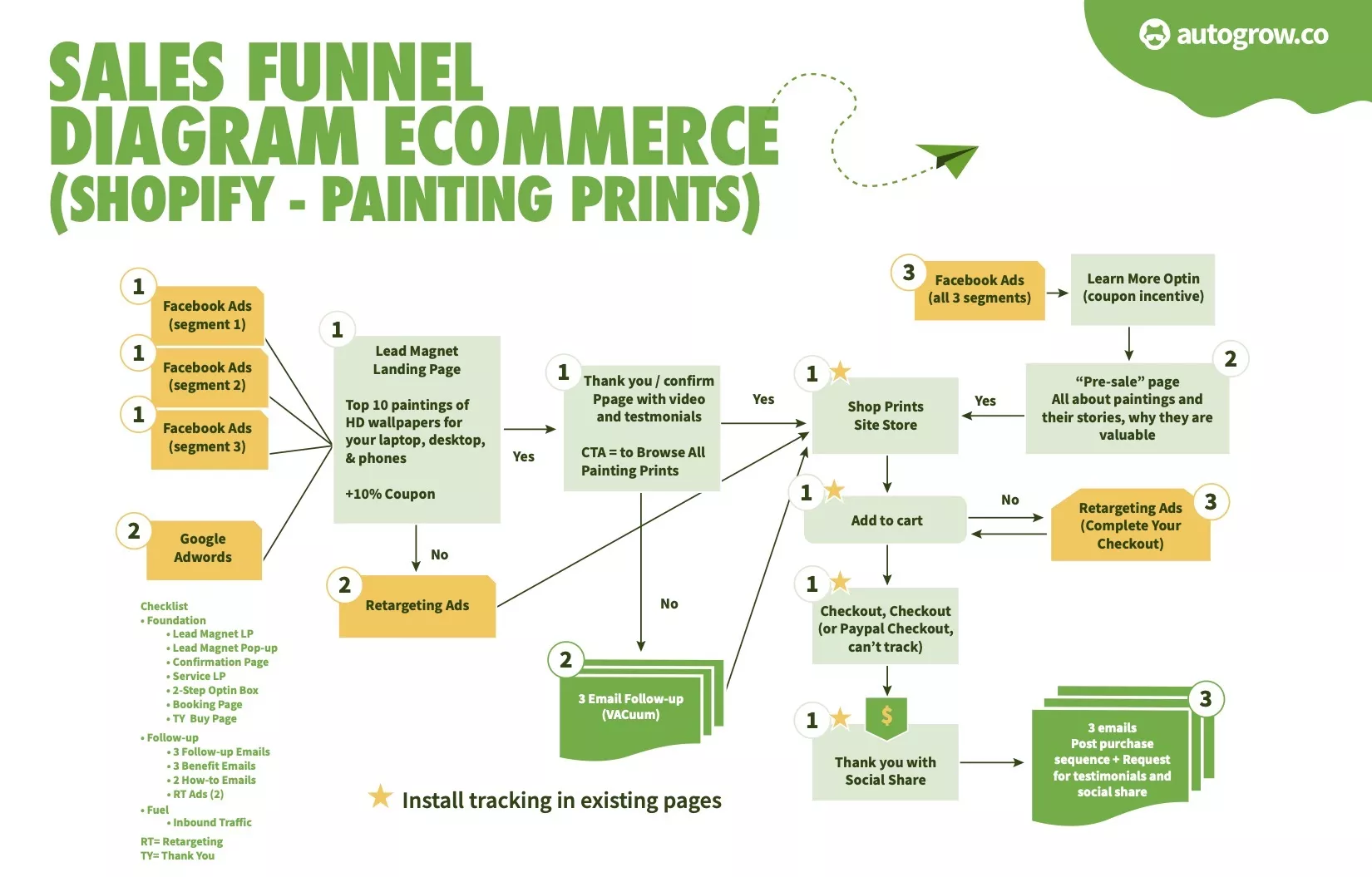
This eCommerce sale funnel comes with a pre-sale page built-in.
This page is designed to inform, nurture, and build anticipation before prospects are directed to the actual shop where they can make their purchase.
That way, leads that land in your shop are warmed up and ready to buy.
#6 Ultimate Sales Funnel Template — Coaching Business Sales Funnel
Professional coaching is becoming an increasingly popular career choice.
According to IBIS World, the coaching business industry measured by revenue, was $13.9bn in 2022.
And at AutoGrow, we’ve worked with plenty of coaches specializing in everything from entrepreneurship, real estate, corporate leadership and more.
And with all that experience, we’ve gotten pretty good at creating high-converting coaching sales funnels for our coaching clients.
Below is one of the best coaching funnels we’ve created for coaches.
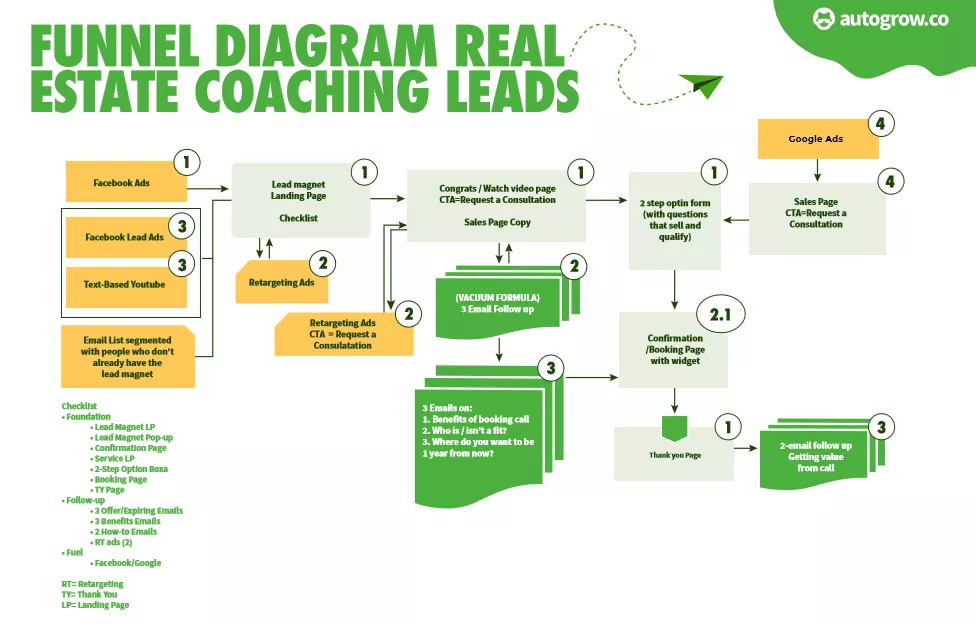
Since personality and human touch play an enormous role in working with a professional coach, this funnel pays particularly close attention to requesting a free consultation.
There are also plenty of nurturing and retargeting elements interspersed throughout the prospect’s journey as well.
Coaching Sales Funnel Template — “The Online Course & Info Product” Sales Funnel
Last but certainly not least, there’s the online courses and info product sales funnel.
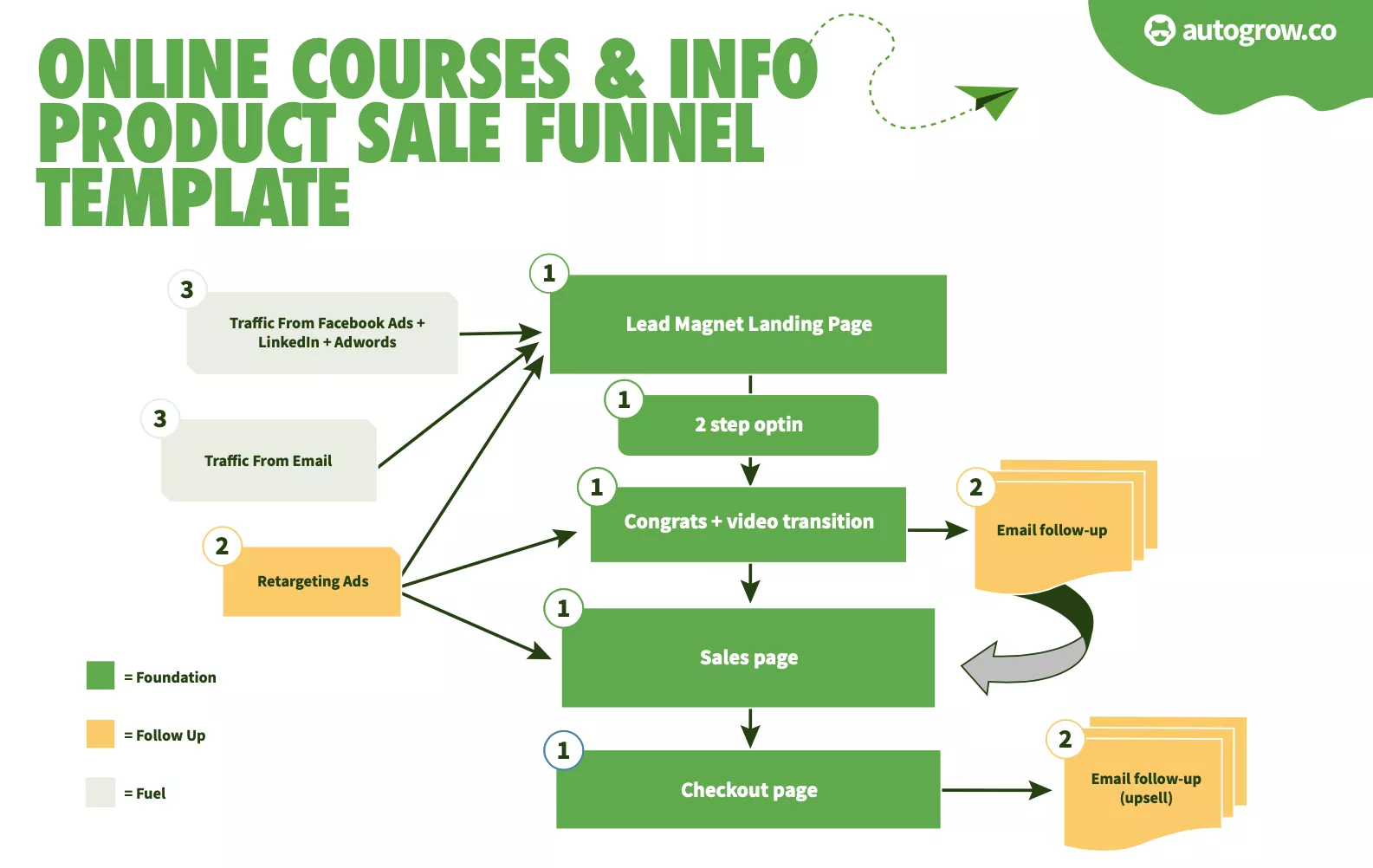
This sales funnel template is designed specifically for businesses selling online courses and info products.
This one is perhaps one of the most basic templates so far.
But don’t be fooled here: as long as the core elements of your funnel are included (lead magnet, sales page, traffic sources, and retargeting tactics), then this funnel template is sure to bring in high-quality and consistent leads that are educated, nurtured, and ready to buy.
Conclusion
So there you have it!
I’ve taken you through the best core sales funnel templates we’ve built and refined over the course of our 13 years in business.
And as long as you follow these sales funnel templates down to a T while also following best practices for copywriting, graphic design, and quality assurance, you’re bound to start seeing leads rushing in.
No matter if you’re a coach, eCommerce, SaaS, or an agency. Or if you sell info products, local events, or online courses.
And of course, setting up a leak-proof and eye-catching sales funnel on your own takes time and it takes expertise to pull off right.
That’s why our clients delegate to AutoGrow their sales funnel strategy and implementation. Because we’ve been building high-converting funnels for 13 years now. And to be perfectly honest, we’ve gotten quite good at it. And we’d love to help you too.
So, which of these sales funnel templates do you plan on using in your business? Do you have any other proven funnel templates that you’ve used to get results?
Let me know in the comments below.
And as always,
Keep funnelin’, stay focused,
![]()
Image Credits:
1. https://clearbit.com/blog/solving-the-sales-rep-productivity-problem
2. https://www.oberlo.com/statistics/us-ecommerce-sales#:~:text=In%202022%2C%20total%20US%20ecommerce,recording%20an%208.5%25%20annual%20increase


